A magnetoelectric sensor is a sensor that converts an input motion velocity into an induced potential output using the principle of electromagnetic induction. It converts the mechanical energy of the object to be measured into an electrical signal that is easy to measure. It is a passive sensor. Magnetoelectric sensors, sometimes referred to as electric or inductive sensors, are only suitable for dynamic measurements. Because of its large output power, the matching circuit is simple; the zero position and performance are stable.
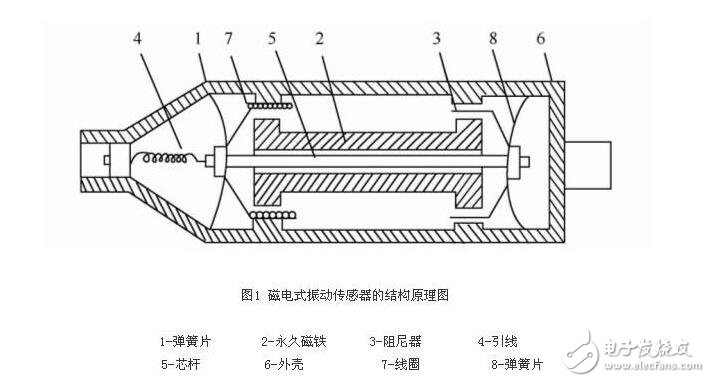
Magnetoelectric sensors, sometimes referred to as electric or inductive sensors, are only suitable for dynamic measurements. Because it has a large output power, the matching circuit is simple; the zero position and the performance are stable;
A force (moment) generator, an electromagnetic exciter, etc. can be constructed by using the inverse conversion effect. According to the law of electromagnetic induction, when the WåŒ coil moves in the constant magnetic field, the magnetic flux passing through the coil is Φ, and the induced potential e in the coil has the following relationship with the flux change rate dΦ/dt:
According to this principle, it is possible to design two types of structures, a variable magnetic formula and a constant magnetic formula, to constitute a magnetoelectric sensor that measures linear velocity or angular velocity. The figure below shows the variable magnetic structure for the measurement of rotational angular velocity and vibration velocity.
Variable magnetic structure
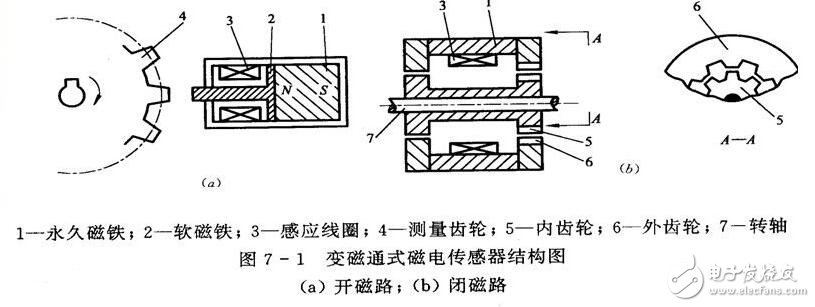
(a) Rotary type (variable magnetic)); (b) Translating type (variable air gap)
The permanent magnet 1 (commonly known as "magnet steel") and the coil 4 are fixed, and the movement of the movable iron core 3 (armature) changes the magnetic gap 5 and the magnetic resistance of the magnetic circuit, causing a change in the magnetic flux to generate an induced potential in the coil, and thus It is called a variable reluctance structure.
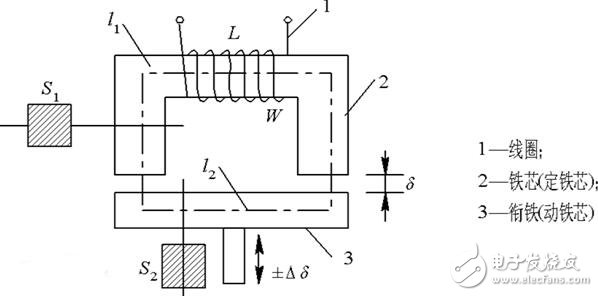
Variable magnetic structure
In the constant magnetic general structure, the magnetic flux in the working air gap is constant, and the induced potential is generated by the relative movement between the permanent magnet and the coil - the coil cuts the magnetic lines of force. There are two types of such structures, as shown in the following figure.
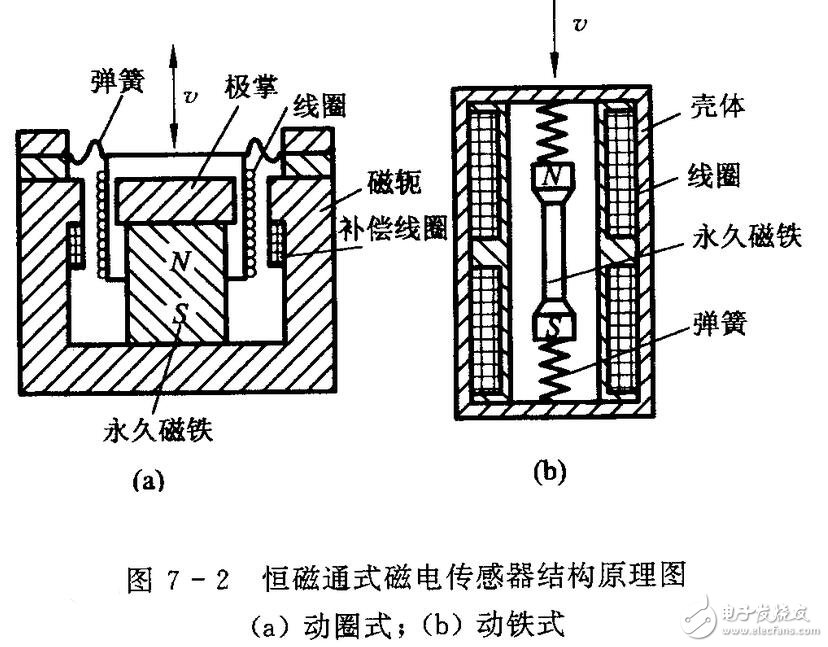
The magnetic circuit system in the figure consists of a cylindrical permanent magnet and a pole palm, a cylindrical yoke and an air gap. The magnetic field in the air gap is evenly distributed, and the measuring coil is wound around the cylindrical skeleton and suspended by the diaphragm spring in the air gap magnetic field.
When there is relative movement between the coil and the magnet, the induced potential e generated in the coil is
Where B is the air gap flux density (T);
l——The total length of the coil (m) with an effective number of turns of W in the air gap magnetic field is l=laW (la is the average length of each coil)
V——relative movement speed of the coil and magnet along the axial direction (ms-1).
When the structure of the sensor is determined, B, la, and W in equation (5-2) are all constant, and the induced potential e is only related to the relative velocity v. The sensitivity of the sensor is
In order to improve the sensitivity, permanent magnets with a large magnetic energy product and a minimum air gap length should be selected to increase the air gap magnetic flux density B; increasing la and W can also improve the sensitivity, but they are subject to volume and weight, internal resistance and Limitations of factors such as working frequency.
In order to ensure the linearity of the sensor output, it is necessary to ensure that the coil always moves within a uniform magnetic field. The designer's task is to select a reasonable structural form, material and structural dimensions to meet the sensor's basic performance requirements.
Various magnetoelectric sensors1. Magnetic induction sensor
(1) Characteristics of magnetoelectric induction sensors
Magnetoelectric induction sensors are referred to as inductive sensors, also known as electric sensors. It converts the measured physical quantity into an induced electromotive force. It is a machine-electric energy conversion type sensor. It does not require an external power supply. The circuit is simple, the performance is stable, the output impedance is small, and it has a certain frequency response range (generally 10). ~1000Hz), suitable for vibration, speed, torque and other measurements. The inertial sensor does not require a stationary base as a reference. It is directly mounted on the vibrating body for measurement, and thus has been widely used in ground vibration measurement and on-board vibration monitoring systems. However, such sensors are large in size and weight.
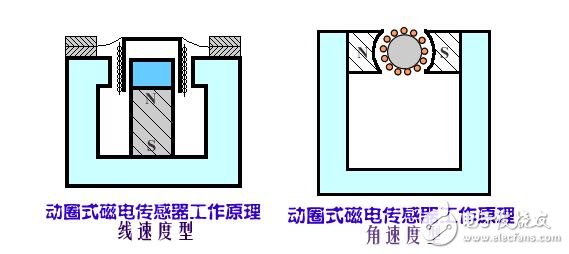
(2) Working principle, classification and application of magnetoelectric induction sensors
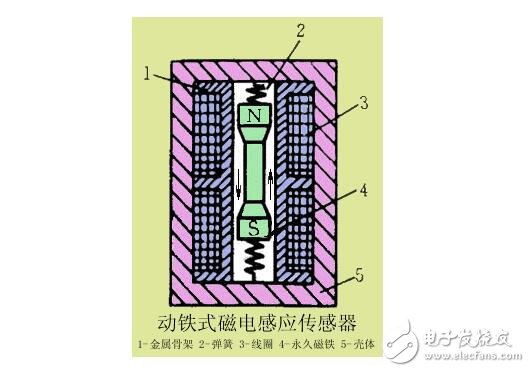
Working principle: According to the law of electromagnetic induction, the NåŒ coil moves in the magnetic field to cut the magnetic field lines, and the induced electromotive force e is generated in the coil. The size of e is related to the rate of change of the magnetic flux Φ passing through the coil. According to different working principles, magnetoelectric induction sensors can be divided into constant magnetic and variable magnetic, namely moving coil sensors and magnetoresistive sensors.
Constant magnetic general-purpose magnetoelectric inductive sensors can be classified into moving coil type and moving iron type according to different moving parts. The middle coil of the moving coil type magnetoelectric sensor is a moving part. The basic form is a speed sensor, which can directly measure the linear velocity or angular velocity. If it is connected to an integrating circuit or a differential circuit in its measuring circuit, it can also be used to measure displacement or acceleration. The moving parts of the moving iron type magnetoelectric inductive sensor are iron cores, which can be used for various vibration and acceleration measurements.
In the variable magnetic general-purpose magnetoelectric induction sensor, the coil and the magnet are stationary, and the rotating object causes magnetoresistance and magnetic flux change, and is commonly used to measure the angular velocity of the rotating object. As shown in the animation, the coil 3 and the magnet 5 are stationary, the measuring gear 1 (made of a magnetic conductive material) rotates one tooth per revolution, the magnetic resistance of the sensor magnetic circuit changes once, and the frequency of the induced electromotive force generated by the coil 3 is equal to the measuring gear. 1 The product of the number of teeth of the upper gear and the rotational speed. The variable magnetic type sensor does not require high environmental conditions, and can work at a temperature of -150 to +90 ° C without affecting the measurement accuracy, and can also work under oil, water mist, dust and the like. However, its lower operating frequency is higher, about 50Hz, and the upper limit is up to 100Hz.
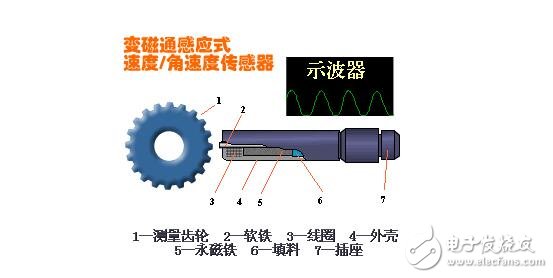
2, Hall sensor
(1) Characteristics of Hall sensors
The Hall sensor is also a magnetoelectric sensor. It is a sensor that uses a Hall element to convert a measurement into an electromotive force output based on the Hall effect principle. Because the Hall element is in a static state, it has the unique ability to sense the magnetic field, and has a simple structure, small volume, low noise, wide frequency range (from DC to microwave), and large dynamic range (output potential range up to 1000:1) ), long life and other characteristics, so it has been widely used.
(2) Hall sensor principle
A metal or semiconductor wafer is placed in a magnetic field, and when a current flows, an electromotive force is generated in a direction perpendicular to the current and the magnetic field. This physical phenomenon is called a Hall effect.
Hall effect principle
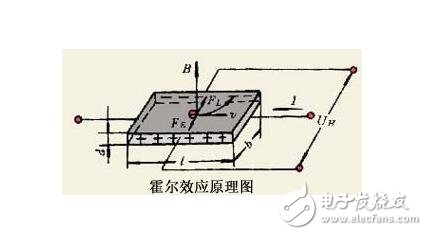
The Hall potential can be expressed by the following formula:

Hall sensors use the Hall effect to detect physical quantities. According to the nature of the objects to be detected, their applications can be divided into direct applications and indirect applications. The former directly detects the magnetic field or magnetic characteristics of the object to be inspected, and the latter detects the artificially set magnetic field on the object to be used, and uses this magnetic field as a carrier for the detected information, through which many non-electrical and non-magnetic materials are used. Physical quantities such as force, moment, pressure, stress, position, displacement, velocity, acceleration, angle, angular velocity, number of revolutions, rotational speed, and time at which the operating state changes are converted into electrical quantities for detection and control.
(3) Application of Hall sensor
To maintain I and q constant, then EH=f(B). In this application, there are Gauss meter for measuring magnetic field strength, Hall tachometer for measuring rotational speed, magnetic product counter, Hall angle encoder and measurement based on minute displacement. The principle of Hall-type accelerometer, micro-pressure gauge, etc.;
If I and B are not changed, then EH=f(q), and the application of this is an angular displacement measuring instrument.
If q is kept constant, then EH=f(IB), that is, the output EH of the sensor is proportional to the product of I and B. Applications such as analog multipliers and Hall-type power meters are used.
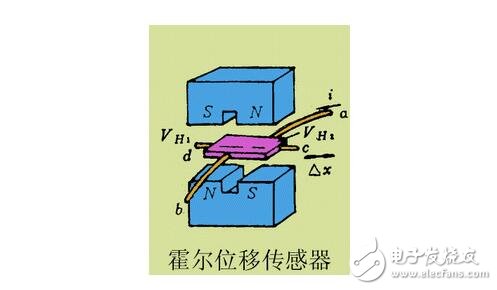
(4) Hall sensor selection considerations
1. Magnetic field measurement. If the accuracy of the measured magnetic field is required to be high, such as better than ±0.5%, the gallium arsenide Hall element is usually selected, and its sensitivity is high, about 5-10 mv/100 mT. The temperature error is negligible, and the material performance is good, Made smaller. The measured magnetic field has low precision and the volume requirement is not high. If the accuracy is less than ±0.5%, it is best to use silicon and germanium components.
2. Current measurement. Most Hall elements can be used for current measurement, requiring high accuracy. When a gallium arsenide Hall element is selected, when the accuracy is not high, a Hall element such as gallium arsenide, silicon or germanium may be selected.
3. Speed ​​and pulse measurement. When measuring the speed and pulse, the integrated Hall switch and the indium antimonide Hall element are usually selected. For example, in the video recorder and camera, the indium-indium Hall element is used instead of the motor brush to improve the service life.
4. Signal calculation and measurement. The function generator is usually manufactured by utilizing the Hall potential in proportion to the control current and the measured magnetic field, and sinusoidally related to the angle between the measured magnetic field and the surface of the Hall element. The Hall element output is proportional to the product of the control current and the measured magnetic field. Manufacturing power meters, electricity meters, etc.
5. Pull and pressure measurements. Sensors made from Hall elements are more sensitive and linear than those made from other materials.
3, magnetoresistance effect sensor
A magnetoresistive element is similar to a Hall element, but it works by utilizing the magnetoresistance effect (or Gaussian effect) of a semiconductor material. The magnetoresistance effect differs from the Hall effect in the direction of the induced electromotive force with respect to the current, the Hall potential is the transverse voltage perpendicular to the direction of the current, and the magnetoresistance effect is the change in resistance along the direction of the current.
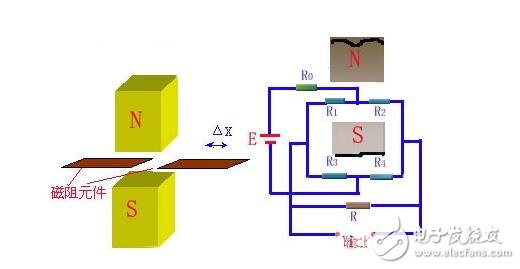
The figure above is a magnetoresistance effect sensor that measures displacement. The magnetoresistive element is placed in a magnetic field. When it is displaced relative to the magnetic field, the internal resistances R1 and R2 of the element change. If they are connected to the bridge, the output voltage is proportional to the change in resistance.
The magnetoresistance effect is related to the material properties and geometry. Generally, the magnetoresistance effect is more pronounced in materials with large mobility. The smaller the aspect ratio, the smaller the magnetoresistance effect.
Magnetoresistive elements can be used to measure parameters such as displacement, force, acceleration, and magnetic fields.
Magnetoelectric applicationVibration sensor
Magnetoelectric sensors are mainly used for vibration measurement. The inertial sensor does not require a stationary base as a reference. It is directly mounted on the vibrating body for measurement, and thus has been widely used in ground vibration measurement and on-board vibration monitoring systems.
Commonly used vibration sensors include moving iron vibration sensors and ring vibration speed sensors.
(one). Application of vibration sensor
Aeroengines, various large motors, air compressors, machine tools, vehicles, sleeper shakers, chemical equipment, various water and gas pipelines, bridges, high-rise buildings, etc., can be used for vibration monitoring and research.
(two). Vibration sensor operating characteristics
The vibration sensor is a typical second-order system with concentrated parameters m, k, and c. As an inertial (absolute) type vibration sensor, it is required to select a larger mass m and a smaller spring constant k.
Thus, at higher vibration frequencies, it is approximately relatively geostationary due to the large inertia of the mass. At this time, the displacement y (output) of the vibrating body (with the sensor housing) relative to the mass can truly reflect the amplitude x (input) of the vibrating body relative to the earth.
Magnetoelectric force generator and vibration exciter
It has been previously pointed out that the magnetoelectric sensor has a bidirectional switching characteristic, and its reverse function can also be utilized. If the power is input to the coil of the speed sensor, the output is mechanical.
The moving coil or moving iron DC torque that is widely used in inertial instruments - gyroscopes and accelerometers is the reverse application of the above speed sensors. It is a very important device in the dynamic experiment of mechanical structure to obtain the dynamic parameters of mechanical structure, such as resonance frequency, stiffness, damping, vibration mode of vibration components and so on.
In addition to the above applications, magnetoelectric sensors are also commonly used for torque, speed and other measurements.
This is a special TOVAPO Z-005 Vape Pen product series. We sell Tovapo Z-005 vape pen disposable,Z-005 vape pen kit, Z-005 vape starter kit, and other Tovapo vapes.
We are specialized electronic cigarette manufacturers from China, Vapes For Smoking, Vape Pen Kits suppliers/factory, wholesale high-quality
products of Modern E-Cigarette R & D and manufacturing, we have the perfect after-sales service and technical support. Look forward to
your cooperation!
Z-005 vape pen disposable,Z-005 vape pen kit, Z-005 vape starter kit,600mah rechargeable vape,600mah rechargeable vape disposable
Ningbo Autrends International Trade Co.,Ltd. , https://www.supermosvape.com